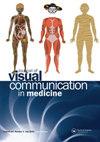A showcase of MA Art in Science research projects (2016-2020) that explore the boundaries of art, anatomy, biology, medicine, microbiology and public health.
IF 0.7
Q4 RADIOLOGY, NUCLEAR MEDICINE & MEDICAL IMAGING
Journal of Visual Communication in Medicine
Pub Date : 2022-01-01
Epub Date: 2021-09-15
DOI:10.1080/17453054.2021.1975495
引用次数: 0
Abstract
Established in 2016, the MA Art in Science programme at Liverpool School of Art and Design, Liverpool John Moores University (LJMU), brings artists and scientists together to collaborate across disciplines. The programme cultivates specialist, transferable skills directed towards future vocational opportunities; and facilitates transdisciplinary learning opportunities that are not often available to those singly defined as ‘artists’, ‘scientists’ or ‘researchers’ (Roughley, Smith, & Wilkinson, 2019). The programme’s core values centre on curiosity and experimentation, and students are encouraged to work beyond existing disciplinary boundaries. The programme begins with an introduction to art-science histories and theories, and focuses on engagement with new or existing art-science research through introductory gestures opened up by practical exploration. As the programme progresses, students engage with current debates and issues within contemporary art-science practice. These include matters relating to bioethics, bioart, working with humans in research and public engagement. Students also begin to develop key partnerships with researchers from art and science research centres at LJMU and in the Liverpool City Region, which ultimately guide the design, development and production of a final research project. These final ‘Major Projects’ are diverse, with topics ranging from an investigation into dark matter through poetry and a dark matter forest installation in a garden shed; to assessing if makeup techniques commonly used by drag artists can help us to avoid facial recognition systems. Amongst other things students have also explored coastal biodiversity by using microscopic diatoms as climate change sensors, and designed 3D printed coral scaffold systems to nurse coral communities back to health. Since the first year of the programme, a number of students have undertaken practice-based research projects that investigate topics specifically related to anatomy, medicine and public health. The gallery that follows features images and abstracts from final research projects undertaken by students from graduating cohorts between 2016 and 2020, which explore the boundaries of boundaries of art, anatomy, biology, medicine, microbiology and public health.MA艺术在科学研究项目(2016-2020)的展示,探索艺术,解剖学,生物学,医学,微生物学和公共卫生的边界。
本文章由计算机程序翻译,如有差异,请以英文原文为准。
求助全文
约1分钟内获得全文
求助全文
来源期刊

Journal of Visual Communication in Medicine
RADIOLOGY, NUCLEAR MEDICINE & MEDICAL IMAGING-
CiteScore
1.50
自引率
14.30%
发文量
34
期刊介绍:
The Journal is a quarterly, international, peer-reviewed journal that acts as a vehicle for the interchange of information and ideas in the production, manipulation, storage and transport of images for medical education, records and research.
 求助内容:
求助内容: 应助结果提醒方式:
应助结果提醒方式:


